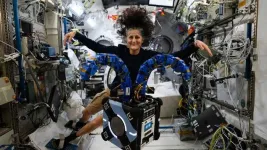(Press-News.org) Chestnut Hill, Mass (01/08/2025) – Nations must start testing and regulating chemicals and chemical products as closely as the current systems that safeguard prescription drugs or risk rising rates of chronic illnesses among children, according to a New England Journal of Medicine report by a group of experts writing as the Consortium for Children’s Environmental Health.
Global chemical inventories contain an estimated 350,000 products – such as manufactured chemicals, chemical mixtures, and plastics. Despite the risks of environmental pollution and human exposure, the manufacture of synthetic chemicals and plastics is subject to insufficient legal or policy constraints.
That regulatory vacuum must be replaced by new laws that prioritize health protection over the rampant production of chemicals and plastics, according to the co-authors, who include Boston College epidemiologist Philip Landrigan, MD, environmental law scholar David Wirth, biologist Thomas Chiles, and epidemiologist Kurt Straif.
“Under new laws, chemicals should not be presumed harmless until they are proven to damage health,” the authors said. “Instead, chemicals and chemical-based products should be allowed to enter markets and remain on markets only if their manufacturers can establish through rigorous, independent, premarket testing that they are not toxic at anticipated levels of exposure.”
In addition, the authors say chemical manufacturers and brands that market chemical products should be required to monitor their products after they have been released to the market in the same way that prescription drugs are monitored in order to evaluate any long-term negative health effects.
The call to action is the result of a two-year project by the group of the world’s most trusted independent scientists from 17 high-profile scientific institutions in the U.S. and Europe. The report was developed to enable a coordinated approach to reduce the ever-increasing levels of chronic disease being faced by children around the world.
Non-communicable diseases (NCDs) are the principal causes of morbidity and mortality in children today, the authors note. Their incidence and prevalence are on the rise. Emerging research links multiple NCDs in children to manufactured synthetic chemicals.
In the past half century, NCDs in children have risen sharply:
● Incidence of childhood cancer has increased by 35 percent
● Male reproductive birth defects have doubled in frequency
● Neurodevelopmental disorders now affect one child in 6, and autism spectrum disorder is diagnosed in one child of 36
● Pediatric asthma has tripled in prevalence
● Prevalence of pediatric obesity has nearly quadrupled and driven a sharp increase in type 2 diabetes among children and adolescents
● Certain chemicals have led to a reduction in IQ and thus massive economic damage
Most synthetic chemicals and related products are produced from fossil fuels – gas, oil, and coal. Production has expanded 50-fold since 1950, and is projected to triple again by 2050. Environmental pollution and human exposure are widespread.
Yet manufacture of synthetic chemicals and plastics is subject to few legal or policy constraints. Unlike pharmaceuticals, synthetic chemicals are brought to market with little prior assessment of their health impacts and almost no postmarketing surveillance for longer-term adverse health effects.
Fewer than 20 percent of these chemicals have been tested for toxicity, and fewer still for toxic effects in infants and children. Associations between widely used chemicals and disease in children continue to be discovered with distressing frequency, and it is likely that there are additional, still unknown links.
Protecting children from chemicals’ dangers will require fundamental revamping of current law and restructuring of the chemical industry, the co-authors write.
Safeguarding children’s health against manufactured synthetic chemicals will require a fundamental shift in chemical law that takes a more precautionary approach and prioritizes health protection over the unconstrained production of synthetic chemicals and plastics, specifically:
● New laws that require chemicals to be tested for safety and toxicity before they are allowed to enter markets
● Mandated chemical footprinting, which operates much like its better-known cousin carbon footprinting
● Safer chemicals, reducing reliance on fossil carbon feedstocks, developing a diverse set of safer, more sustainable molecules and manufacturing processes
● Policy reform, create a new legal paradigm for chemical management at a national level and a new global chemicals treaty
“Pollution by synthetic chemicals and plastics is one of the great planetary challenges of our time,” said lead author Landrigan, the director of Boston College’s Observatory on Planetary Health. “It is worsening rapidly. Continued unchecked increases in the production of chemicals based on fossil carbon endangers the world’s children and threatens humanity’s capacity for reproduction.”
END
Synthetic chemicals and chemical products require a new regulatory and legal approach to safeguard children’s health
Few legal or policy constraints apply to the global chemical inventories of an estimated 350,000 products, according to the Consortium for Children’s Environmental Health
2025-01-08
ELSE PRESS RELEASES FROM THIS DATE:
The genes that grow a healthy brain could fuel adult glioblastoma
2025-01-08
FOR IMMEDIATE RELEASE
Media Contact: Levi.Gadye@ucsf.edu, (415) 502-6397
Subscribe to UCSF News
The discovery of a new type of stem cell in the brain could usher in better treatments for the deadliest brain tumor.
UCSF scientists have discovered a stem cell in the young brain that’s capable of forming the cells found in tumors. The breakthrough could explain how adult brain cells take advantage of developmental processes to instigate the explosive growth seen in deadly brain cancers like glioblastoma.
They made the discovery while taking a broad genomic survey of human brain ...
New MSU study explains the delayed rise of plants, animals on land
2025-01-08
EAST LANSING, Mich. – If you like the smell of spring roses, the sounds of summer birdsong and the colors of fall foliage, you have the stabilization of the ozone layer to thank for it. Located in the stratosphere where it shields the Earth from harmful ultraviolet radiation, the ozone layer plays a key role in preserving the planet’s biodiversity.
Now, we may have a better idea of why that took more than 2 billion years to happen.
Michigan State University researcher Dalton Hardisty contributed to a new Yale University-led study finding that Earth’s early atmosphere hosted a battle royal between ...
UTA becomes one of largest natural history libraries
2025-01-08
Thanks to in-kind donations of tens of thousands of rare books, scientific journals, and articles, and reports over the past two years, The University of Texas at Arlington’s Amphibian and Reptile Diversity Research Center (ARDRC) has become one of the largest publicly accessible herpetology libraries in the world.
“Thanks to 12 independent donors, including the Joseph Rex Dinardo Jr. Herpetology and Natural History Science Research Trust in Philadelphia, Dr. Jonathan Campbell, William Lamar, Drs. Jay and Rebecca Savage, and Louis Porras, we now have thousands ...
Number of autistic individuals enrolled in Medicaid and receiving federal housing support increased by 70% from 2008-16
2025-01-08
Affordable and stable housing is critical to improving health across a person's lifespan. People with disabilities, including autism, comprise a significant share of people in need of housing assistance. However, the intersection of housing and health among individuals with autism is largely unknown because data on public housing and public health are not connected. Researchers from Drexel University’s A.J. Drexel Autism Institute examined how many autistic people in the United States received housing ...
St. Jude scientists create scalable solution for analyzing single-cell data
2025-01-08
Researchers have amassed vast single-cell gene expression databases to understand how the smallest details impact human biology. However, current analysis methods struggle with the large volume of data and, as a result, produce biased and contradictory findings. Scientists at St. Jude Children’s Research Hospital created a machine-learning algorithm capable of scaling with these single-cell data repositories to deliver more accurate results. The new method was published today in Cell Genomics.
Before single-cell analysis, bulk gene expression data ...
What is the average wait time to see a neurologist?
2025-01-08
MINNEAPOLIS – Older people wait an average of just over a month to see a neurologist for specialty care after being referred by their primary care physician or another physician, according to a study published in the January 8, 2025, online issue of Neurology®, the medical journal of the American Academy of Neurology. The study, which looked at people who have Medicare insurance, also found some people wait more than three months to see a neurologist.
“Neurologists provide important and ongoing care for people ...
Proximity effect: Method allows advanced materials to gain new property
2025-01-08
UNIVERSITY PARK, Pa. — Ferroelectrics are special materials with polarized positive and negative charges — like a magnet has north and south poles — that can be reversed when external electricity is applied. The materials will remain in these reversed states until more power is applied, making them useful for data storage and wireless communication applications.
Now, turning a non-ferroelectric material into one may be possible simply by stacking it with another ferroelectric material, according to a team led by scientists from Penn State who demonstrated the phenomenon, called proximity ferroelectricity.
The ...
LJI researchers shed light on devastating blood diseases
2025-01-08
LA JOLLA, CA—Scientists at La Jolla Institute for Immunology (LJI) have discovered how a mutated gene kicks off a dangerous chain of events during blood cell production.
The study, published recently in the Proceedings of the National Academy of Sciences, reveals how a mutated gene called ASXL1 is involved in a disease called clonal hematopoiesis, a precursor to malignant diseases such as myeloid malignancies and chronic monomyelocytic leukemia.
"We know that many diseases—and all cancers—are driven by mutations in the genome," says LJI Instructor Zhen Dong, ...
ISS National Lab announces up to $650,000 in funding for technology advancement in low Earth orbit
2025-01-08
KENNEDY SPACE CENTER (FL), January 7, 2025 – The International Space Station (ISSInternational Space Station) National Laboratory is soliciting flight concepts for technology advancement that utilizes the space-based environment of the orbiting laboratory. This solicitation, “Technology Advancement and Applied Research Leveraging the ISS National Lab,” is open to a broad range of technology areas, including chemical and material synthesis in space, translational medicine, in-space edge computing, and in-space servicing, assembly, and manufacturing. It also encompasses the application of space station remote sensing data to improve geospatial analytics ...
Scientists show how sleep deprived brain permits intrusive thoughts
2025-01-08
A new study has shown that sleep deprivation can inhibit the brain’s ability to suppress unwanted memories and intrusive thoughts.
Scientists at the University of York, in collaboration with the University of East Anglia, have shown that sleep deprivation interferes with the ability of the prefrontal area of the brain to restrict the retrieval of memories that would have otherwise been suppressed.
Dr Scott Cairney from the University of York said: “Memories of unpleasant experiences often intrude into our conscious ...
LAST 30 PRESS RELEASES:
Heart-brain connection: international study reveals the role of the vagus nerve in keeping the heart young
Researchers identify Rb1 as a predictive biomarker for a new therapeutic strategy in some breast cancers
Survey reveals ethical gaps slowing AI adoption in pediatric surgery
Stimulant ADHD medications work differently than thought
AI overestimates how smart people are, according to HSE economists
HSE researchers create genome-wide map of quadruplexes
Scientists boost cell "powerhouses" to burn more calories
Automatic label checking: The missing step in making reliable medical AI
Low daily alcohol intake linked to 50% heightened mouth cancer risk in India
American Meteorological Society announces Rick Spinrad as 2026 President-Elect
Biomass-based carbon capture spotlighted in newly released global climate webinar recording
Illuminating invisible nano pollutants: advanced bioimaging tracks the full journey of emerging nanoscale contaminants in living systems
How does age affect recovery from spinal cord injury?
Novel AI tool offers prognosis for patients with head and neck cancer
Fathers’ microplastic exposure tied to their children’s metabolic problems
Research validates laboratory model for studying high-grade serous ovarian cancer
SIR 2026 delivers transformative breakthroughs in minimally invasive medicine to improve patient care
Stem Cell Reports most downloaded papers of 2025 highlight the breadth and impact of stem cell research
Oxford-led study estimates NHS spends around 3% of its primary and secondary care budget on the health impacts of heat and cold in England
A researcher’s long quest leads to a smart composite breakthrough
Urban wild bees act as “microbial sensors” of city health.
New study finds where you live affects recovery after a hip fracture
Forecasting the impact of fully automated vehicle adoption on US road traffic injuries
Alcohol-related hospitalizations from 2016 to 2022
Semaglutide and hospitalizations in patients with obesity and established cardiovascular disease
Researchers ‘listen in’ to embryo-mother interactions during implantation using a culture system replicating the womb lining
How changing your diet could help save the world
How to make AI truly scalable and reliable for real-time traffic assignment?
Beyond fragmented markets: A new framework for efficient and stable ride-pooling
Can shape priors make road perception more reliable for autonomous driving?
[Press-News.org] Synthetic chemicals and chemical products require a new regulatory and legal approach to safeguard children’s healthFew legal or policy constraints apply to the global chemical inventories of an estimated 350,000 products, according to the Consortium for Children’s Environmental Health



